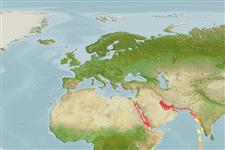>
Pleuronectiformes (Flatfishes) >
Soleidae (Soles)
Etymology: Aseraggodes: Greek, aggos, -eos, -ous = vessel, uterus, carapace of a crab + Greek, aseros, -a, -on = to remove the appetite (Ref. 45335).
More on author: Chabanaud.
Environment: milieu / climate zone / depth range / distribution range
Ekologi
laut dasar (demersal); kisaran kedalaman 35 - 68 m (Ref. 57561). Tropical
Western Indian Ocean: Red Sea.
Size / Weight / umur
Maturity: Lm ? range ? - ? cm
Max length : 7.9 cm SL jantan/; (Ref. 57561)
deskripsi pendek
Morfologi | Morfometrik
duri punggung lunak (Keseluruhan (total)): 59-67; Sirip dubur lunak: 40 - 45; vertebrata, bertulang belakang: 35. Diagnosis: Dorsal rays 62 (59-67); anal rays 43 (40-45); dorsal and anal rays unbranched; caudal rays 18, the upper 3 and lower 2 unbranched, the remaining rays mostly double branched; pelvic rays 5, unbranched; lateral-line scales 62 (62-72), including 8 (7-10) anterior to upper end of gill opening; lateral line projecting anteriorly toward dorsal edge of upper eye; vertebrae 35 (5 specimens) to 36 (5 specimens); dorsal pterygiophores anterior to fourth neural spine 10-11 (one of nine with 10); body depth 2.3-2.7 in SL; head length (HL) 3.45-4.15 in SL. Remaining measurements just for lectotype: snout 3.05 in HL; preorbital length 3.5 in HL; eye diameter 6.95 in HL; interorbital space 16.5 in HL; tubular anterior nostril short, not reaching cutaneous anterior edge of eye when laid back; maxilla extending posterior to a vertical through middle of lower eye, the upper-jaw length 3.8 in HL; upper end of gill opening on a horizontal passing through ventral edge of lower eye; cirri on front of snout and ventral side of head slender and small; slender cirri along edge of operculum at gill opening on blind side; no cirri detected on dorsal or anal rays; no caudal peduncle depth of caudal-fin base 1.7 in HL; longest dorsal and anal rays 1.6 in HL; caudal fin short, 4.3 in SL; pelvic-fins just reaching base of second anal ray, the ocular-side pelvic fin longer; longest pelvic ray 2.7 in HL; color of ocular side of lectotype tan, the fins pale yellowish; color in formalin as reported: very pale, uniformly and densely dotted with brown, with some larger dots of the same shade of brown, especially on fins (Ref. 57561).
Life cycle and mating behavior
Kematangan | Reproduksi, perkembang biakan | Pemijahan | telur-telur | Fecundity | Larva
Goren, M. and M. Dor, 1994. An updated checklist of the fishes of the Red Sea (CLOFRES II). The Israel Academy of Sciences and Humanities, Jerusalem, Israel. 120 p. (Ref. 12541)
Status IUCN Red List (Ref. 130435)
ancaman kepada manusia
Harmless
penggunaan manusia
informasi lanjut
Nama-nama umumSinonim (persamaan)metabolismePemangsaEkotoksikologiReproduksi, perkembang biakanKematanganPemijahanSpawning aggregationFecunditytelur-telurpekembangan telor
Umur / SaizPertumbuhanpanjang-beratpanjang-panjangukuran frekuensiMorfometrikMorfologiLarvaDinamika larvapemulihanKelimpahanBRUVS
AcuanBudidaya airprofil budidaya airStrainGenetikaElectrophoresesDiturunkanPenyakit-penyakitPengolahanNutrientsMass conversion
mitraGambarStamps, Coins Misc.Suara-suaraCiguateraKecepatanTipe renangArea insangOtolithsOtakPenglihatan / visi
Alat, peralatan
laporan khas
muat turun XML
Sumber internet
Estimates based on models
Preferred temperature (Ref.
123201): 22.3 - 28.2, mean 23.6 °C (based on 20 cells).
Phylogenetic diversity index (Ref.
82804): PD
50 = 0.5000 [Uniqueness, from 0.5 = low to 2.0 = high].
Bayesian length-weight: a=0.00977 (0.00473 - 0.02021), b=3.07 (2.90 - 3.24), in cm total length, based on LWR estimates for this (Sub)family-body shape (Ref.
93245).
Trophic level (Ref.
69278): 3.5 ±0.5 se; based on size and trophs of closest relatives
Daya lenting (Ref.
120179): Tinggi, Waktu penggandaan populasi minimum kurang dari 15 bulan (Preliminary K or Fecundity.).
Fishing Vulnerability (Ref.
59153): Low vulnerability (10 of 100).
